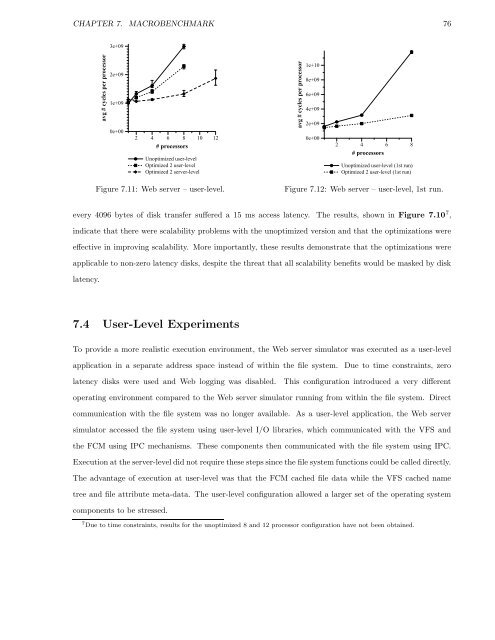Performance Analysis and Optimization of the Hurricane File System ...
Performance Analysis and Optimization of the Hurricane File System ...
Performance Analysis and Optimization of the Hurricane File System ...
You also want an ePaper? Increase the reach of your titles
YUMPU automatically turns print PDFs into web optimized ePapers that Google loves.
CHAPTER 7. MACROBENCHMARK 76<br />
avg # cycles per processor<br />
3e+09<br />
2e+09<br />
1e+09<br />
0e+00<br />
2 4 6 8 10 12<br />
# processors<br />
Unoptimized user-level<br />
Optimized 2 user-level<br />
Optimized 2 server-level<br />
Figure 7.11: Web server – user-level.<br />
avg # cycles per processor<br />
1e+10<br />
8e+09<br />
6e+09<br />
4e+09<br />
2e+09<br />
0e+00<br />
2 4 6 8<br />
# processors<br />
Unoptimized user-level (1st run)<br />
Optimized 2 user-level (1st run)<br />
Figure 7.12: Web server – user-level, 1st run.<br />
every 4096 bytes <strong>of</strong> disk transfer suffered a 15 ms access latency. The results, shown in Figure 7.10 7 ,<br />
indicate that <strong>the</strong>re were scalability problems with <strong>the</strong> unoptimized version <strong>and</strong> that <strong>the</strong> optimizations were<br />
effective in improving scalability. More importantly, <strong>the</strong>se results demonstrate that <strong>the</strong> optimizations were<br />
applicable to non-zero latency disks, despite <strong>the</strong> threat that all scalability benefits would be masked by disk<br />
latency.<br />
7.4 User-Level Experiments<br />
To provide a more realistic execution environment, <strong>the</strong> Web server simulator was executed as a user-level<br />
application in a separate address space instead <strong>of</strong> within <strong>the</strong> file system. Due to time constraints, zero<br />
latency disks were used <strong>and</strong> Web logging was disabled. This configuration introduced a very different<br />
operating environment compared to <strong>the</strong> Web server simulator running from within <strong>the</strong> file system. Direct<br />
communication with <strong>the</strong> file system was no longer available. As a user-level application, <strong>the</strong> Web server<br />
simulator accessed <strong>the</strong> file system using user-level I/O libraries, which communicated with <strong>the</strong> VFS <strong>and</strong><br />
<strong>the</strong> FCM using IPC mechanisms. These components <strong>the</strong>n communicated with <strong>the</strong> file system using IPC.<br />
Execution at <strong>the</strong> server-level did not require <strong>the</strong>se steps since <strong>the</strong> file system functions could be called directly.<br />
The advantage <strong>of</strong> execution at user-level was that <strong>the</strong> FCM cached file data while <strong>the</strong> VFS cached name<br />
tree <strong>and</strong> file attribute meta-data. The user-level configuration allowed a larger set <strong>of</strong> <strong>the</strong> operating system<br />
components to be stressed.<br />
7 Due to time constraints, results for <strong>the</strong> unoptimized 8 <strong>and</strong> 12 processor configuration have not been obtained.














